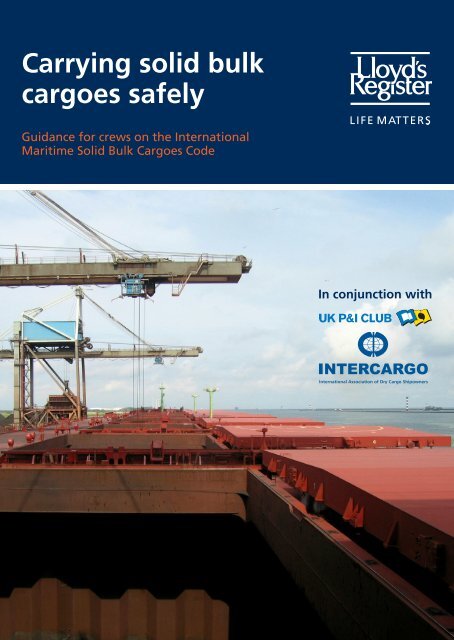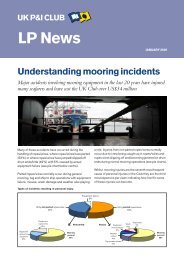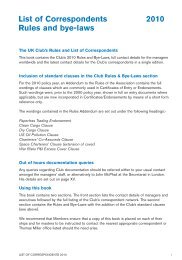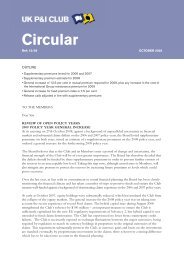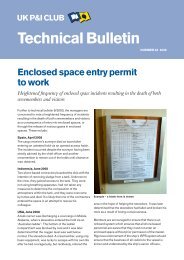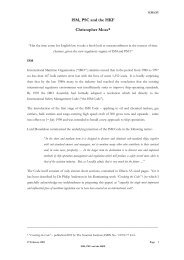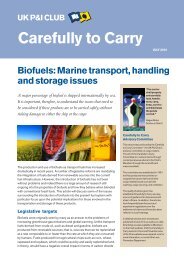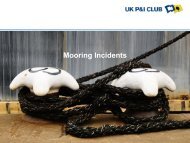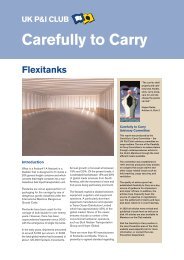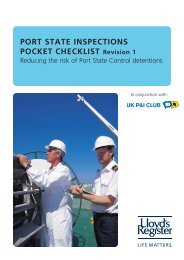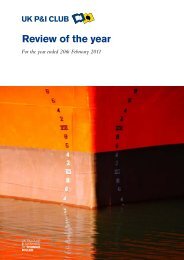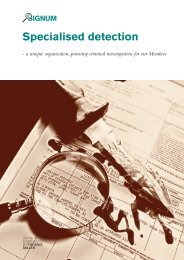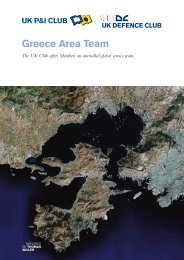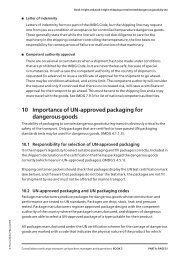IMSBC Code pocket guide.pdf - UK P&I
IMSBC Code pocket guide.pdf - UK P&I
IMSBC Code pocket guide.pdf - UK P&I
Create successful ePaper yourself
Turn your PDF publications into a flip-book with our unique Google optimized e-Paper software.
Carrying solid bulk<br />
cargoes safely<br />
Guidance for crews on the International<br />
Maritime Solid Bulk Cargoes <strong>Code</strong><br />
In conjunction with
Contents<br />
Introduction<br />
1. General requirements for carrying solid bulk cargoes<br />
Accepting cargoes for shipment<br />
Loading<br />
2. The <strong>Code</strong>’s three cargo groups<br />
Group A cargoes – cargoes which may liquefy<br />
Group B cargoes – cargoes with chemical hazards<br />
Group C cargoes – cargoes which are neither liable to<br />
liquefy nor possess chemical hazards<br />
3. Other hazards associated with carrying solid bulk cargoes<br />
4. Checklist and flowchart for accepting and loading solid<br />
bulk cargoes<br />
Appendix 1<br />
IMO regulations and guidance relating to the transport of solid bulk cargoes<br />
Appendix 2<br />
The <strong>Code</strong> section by section<br />
3<br />
4<br />
4<br />
6<br />
7<br />
8<br />
10<br />
14<br />
15<br />
16<br />
19<br />
21<br />
Carrying solid bulk cargoes safely<br />
© Lloyd’s Register/<strong>UK</strong> P&I Club/Intercargo, 2013 Page 2
Introduction<br />
Carrying solid bulk cargoes involves serious risks, which must be managed<br />
carefully to safeguard the crew and the ship. These risks include reduced ship<br />
stability, (and even capsizing, capsizing) due to cargo liquefaction; fire or explosion due to<br />
chemical hazards; and damage to ship structures due to poor loading procedures.<br />
The main legislation governing safe carriage of solid bulk cargoes is the<br />
International Maritime Solid Bulk Cargoes (<strong>IMSBC</strong>) <strong>Code</strong>, which became<br />
mandatory on January 1, 2011, under the SOLAS Convention 1 .<br />
This <strong>pocket</strong> <strong>guide</strong> will help you understand the <strong>IMSBC</strong> <strong>Code</strong>’s key requirements<br />
and give you greater confidence in managing the risks of associated carrying with solid the bulk<br />
cargoes carriage and of solid achieving bulk cargoes. compliance It outlines with SOLAS. the precautions It outlines you the should precautions take before you<br />
should accepting take cargoes before for accepting shipment cargoes and the for procedures shipment and you the should procedures follow for you safe should<br />
follow loading for and safe carriage, loading and details carriage, the and primary details hazards the primary associated hazards with associated the different<br />
with types the of solid different bulk types cargo. of solid bulk cargo.<br />
It also contains a quick reference checklist and flowchart summarising the steps<br />
you need to follow.<br />
Note: This <strong>guide</strong> is only an introduction to the <strong>IMSBC</strong> <strong>Code</strong>; you should always<br />
consult Note: the This full <strong>guide</strong> <strong>Code</strong> is only to check an introduction the requirements to the for <strong>IMSBC</strong> each <strong>Code</strong>; cargo you should are carrying. It<br />
does always not consult cover carriage the full of <strong>Code</strong> grain to in check bulk; the this requirements is covered by for the each International cargo you Grain<br />
<strong>Code</strong>. are carrying. It does not cover carriage of grain in bulk; this is covered by the<br />
International Grain <strong>Code</strong>.<br />
Look for “Consult the <strong>Code</strong>” headings within this publication, which refer<br />
you Look to for specific “Consult sections the of <strong>Code</strong>” the <strong>Code</strong> headings for more within information. this publication, which<br />
refer you to specific sections of the <strong>Code</strong> for more information.<br />
1<br />
For a list of other IMO legislation and guidance relating to bulk cargoes, see Appendix 1.<br />
Carrying solid bulk cargoes safely<br />
© Lloyd’s Register/<strong>UK</strong> P&I Club/Intercargo, 2013 Page 3
1. General requirements for<br />
carrying solid bulk cargoes<br />
No matter what solid bulk cargo you are carrying, the same general requirements<br />
apply for accepting them for shipment and loading them. Section 2 of this <strong>pocket</strong><br />
<strong>guide</strong> covers the typical requirements for different types of cargo.<br />
Accepting cargoes for shipment<br />
Information required from the shipper<br />
Before you can accept a cargo for shipment, the shipper must provide the Master<br />
with valid, up-to-date information about the cargo’s physical and chemical<br />
properties. The exact information and documentation they must provide is<br />
listed in the <strong>Code</strong> under ‘Assessment of acceptability of consignments for safe<br />
shipment; Provision of Information’, and includes the correct Bulk Cargo Shipping<br />
Name 2 and a declaration that the cargo information is correct.<br />
Consult the <strong>Code</strong> – see Section 4<br />
Checking the cargo schedule<br />
Individual cargoes are listed in<br />
‘schedules’ which are contained<br />
in Appendix 1 of the <strong>Code</strong>. These<br />
describe each cargo’s properties<br />
and detail the requirements for<br />
handling, stowing and carrying it<br />
safely. You must always consult the<br />
relevant schedule in the <strong>Code</strong> to find<br />
out what hazards the cargo presents.<br />
Consult the <strong>Code</strong> – see Appendix 1<br />
Cargo being worked<br />
2<br />
This is the cargo’s official name used in the <strong>Code</strong>.<br />
Carrying solid bulk cargoes safely<br />
© Lloyd’s Register/<strong>UK</strong> P&I Club/Intercargo, 2013 Page 4
Accepting cargoes not listed in the <strong>IMSBC</strong> <strong>Code</strong><br />
The list of individual cargoes contained in the <strong>Code</strong> is not exhaustive. If a cargo<br />
not listed in the <strong>Code</strong> is presented for shipment, the shipper and the appropriate<br />
competent authorities 3 must follow this process:<br />
1. Before loading, the shipper must provide details of the characteristics and<br />
properties of the cargo to the competent authority of the port of loading.<br />
2. Based on this information the competent authority of the port of loading<br />
will assess the acceptability of the cargo for shipment.<br />
– If the assessment defines the cargo as Group A or B 4 , the competent<br />
authorities 3 will set the preliminary suitable conditions for carriage.<br />
– If the cargo is Group C 4 then carriage can be authorised by the port of<br />
loading and the competent authorities of the unloading port and flag<br />
state will be informed of the authorisation.<br />
3. In both cases, the competent authority of the port of loading will give the<br />
Master a certificate stating the characteristics of the cargo and the required<br />
conditions for carriage and handling. The competent authority of the port of<br />
loading will also provide the same information to the IMO.<br />
Consult the <strong>Code</strong> – see Section 1.3<br />
Exemptions<br />
Under section 1.5 of the <strong>Code</strong>, a competent authority (or authorities) can grant an<br />
exemption which allows ships to carry a cargo outside the requirements specified<br />
in its schedule, provided that equivalent provisions have been put in place.<br />
Agreement of all three competent authorities is required to ship a cargo under<br />
an exemption. Acceptance of an exemption by authorities not party to it is<br />
discretionary: i.e., if the loading port authority issues an exemption, the unloading<br />
port and flag state authorities can choose to accept it or reject it.<br />
An exemption can be valid for up to five years and does not necessarily lead to the<br />
creation of a new or revised schedule.<br />
Consult the <strong>Code</strong> – see Section 1.5<br />
3<br />
The competent authorities of the port of loading, the port of unloading and the flag state.<br />
4<br />
The <strong>Code</strong> categorises cargo into three Groups – A, B and C. See page 7 for their definitions.<br />
Carrying solid bulk cargoes safely<br />
© Lloyd’s Register/<strong>UK</strong> P&I Club/Intercargo, 2013 Page 5
Loading<br />
Inspecting and preparing cargo spaces<br />
In general, before loading a cargo you must inspect and prepare the cargo spaces,<br />
checking that:<br />
– bilge wells and strainer plates are prepared to facilitate drainage and prevent<br />
cargo entering the bilge system<br />
– bilge lines, sounding pipes and other service lines are in good order<br />
– cargo space fittings are protected from damage, and<br />
– measures are in place to minimise dust entering living quarters or other<br />
interior spaces, or coming into contact with moving parts of deck machinery<br />
and external navigational aids.<br />
Distribution and stability<br />
You must also make sure that cargoes are properly distributed throughout the<br />
ship’s holds to provide adequate stability and ensure that the ship’s structure is<br />
never overstressed. Information can be found in the ship’s stability information<br />
booklet or you can use loading calculators if they are available. The Master will<br />
need to calculate the stability for the anticipated worst conditions during the<br />
voyage as well as for departure and demonstrate that the stability is adequate.<br />
Loading Plan<br />
Before loading or unloading, the Master and the terminal representative must<br />
agree a Loading Plan to ensure that the permissible forces and moments on the<br />
ship are not exceeded. What this Plan should include is detailed in the <strong>Code</strong> of<br />
Practice for the Safe Loading and Unloading of Bulk Carriers (the BLU <strong>Code</strong>) and<br />
in the checklist on page 16.<br />
Carrying solid bulk cargoes safely<br />
© Lloyd’s Register/<strong>UK</strong> P&I Club/Intercargo, 2013 Page 6
2. The <strong>Code</strong>’s three cargo groups<br />
The <strong>IMSBC</strong> <strong>Code</strong> categorises cargoes into three groups:<br />
Group A – cargoes which may liquefy if shipped at a moisture content exceeding<br />
their Transportable Moisture Limit (TML) 5 .<br />
Group B – cargoes which possess a chemical hazard which could give rise to a<br />
dangerous situation on a ship.<br />
Group C – cargoes which are neither liable to liquefy (Group A) nor possess<br />
chemical hazards (Group B). Cargoes in this group can still be hazardous.<br />
You can find the Group for a particular cargo in its schedule.<br />
Liquefied nickel ore (Image courtesy of MTD)<br />
5<br />
The TML is the maximum moisture content considered safe for carriage. See page 9.<br />
Carrying solid bulk cargoes safely<br />
© Lloyd’s Register/<strong>UK</strong> P&I Club/Intercargo, 2013 Page 7
Group A cargoes (cargoes which may liquefy)<br />
What is liquefaction and how does it affect cargo?<br />
Liquefaction means that a cargo becomes fluid (liquefies). On ships, this happens<br />
when the cargo is compacted by the ship’s motion. Cargoes which are prone to<br />
liquefaction contain a certain quantity of moisture and small particles, although they<br />
may look relatively dry and granular when loaded. Liquefaction can lead to cargo<br />
shift 6 and even to the capsize and total loss of the ship, and can occur even when<br />
cargoes are cohesive and trimmed level.<br />
Consult the <strong>Code</strong> – see Section 7<br />
Examples of Group A cargoes<br />
Mineral concentrates<br />
Mineral concentrates are refined ores in which valuable components have been<br />
enriched by eliminating most waste materials. They include copper concentrate,<br />
iron concentrate, lead concentrate, nickel concentrate and zinc concentrate.<br />
Nickel ore 7<br />
There are several types of nickel ore which<br />
vary in colour, particle size and moisture<br />
content. Some may contain clay-like ores.<br />
Coal<br />
Coal (bituminous and anthracite) is a<br />
natural, solid, combustible material<br />
consisting of amorphous carbon and<br />
hydrocarbons. It is best known as a Group<br />
B cargo due to its flammable and selfheating<br />
properties, but it can also be<br />
classed as Group A because it can liquefy if<br />
predominantly fine (i.e., if 75% is made up<br />
of particles less than 5mm in size). In these<br />
cases, it is classed as both Group A and B.<br />
Coal being loaded. Coal is most<br />
commonly a Group B cargo, but<br />
can also be classed as both A and B.<br />
6<br />
Cargo shift can be divided into two types: sliding failure or liquefaction consequence. Trimming the<br />
cargo can prevent sliding failure.<br />
7<br />
Nickel ore is not to be confused with nickel concentrate.<br />
Carrying solid bulk cargoes safely<br />
© Lloyd’s Register/<strong>UK</strong> P&I Club/Intercargo, 2013 Page 8
Typical requirements for accepting<br />
and loading Group A cargoes<br />
Information required from the shipper<br />
To control the risks of liquefaction, Group<br />
A cargoes are tested to determine their<br />
Transportable Moisture Limit (TML) and<br />
their actual moisture content before they<br />
can be shipped. The TML is the maximum<br />
moisture content considered safe for carriage.<br />
The actual moisture content of the cargo<br />
must be below the TML.<br />
The information supplied by the shipper<br />
to the master must include a signed<br />
certificate stating the TML, and a signed<br />
certificate or declaration of the cargo’s<br />
actual moisture content.<br />
Hui Long, a bulk carrier which<br />
sank in 2005. The cause was<br />
believed to be liquefaction,<br />
possibly due to the TML<br />
being exceeded.<br />
What you need to do<br />
Follow these steps when carrying Group A cargoes to reduce the risk of liquefaction:<br />
– Make sure the shipper has supplied the required information, including the<br />
TML and the actual moisture content.<br />
– Only accept the cargo if the actual moisture content is less than its TML.<br />
– Carry out visual monitoring during loading. If there are any indications of high<br />
moisture content, stop loading and seek further advice.<br />
– Consider trimming the cargo to reduce the likelihood of cargo shift.<br />
– Take measures to prevent water or other liquids entering the cargo space<br />
during loading and throughout the voyage.<br />
Practical guidance on managing the risks of liquefaction is also available from the<br />
<strong>UK</strong> P&I Club at www.ukpandi.com/loss-prevention<br />
Consult the <strong>Code</strong> – see Sections 7 and 8<br />
Carrying solid bulk cargoes safely<br />
© Lloyd’s Register/<strong>UK</strong> P&I Club/Intercargo, 2013 Page 9
Group B cargoes (cargoes with chemical hazards)<br />
Group B cargoes are classified in two ways within the <strong>Code</strong>: ‘Dangerous goods<br />
in solid form in bulk’ (under the International Maritime Dangerous Goods (IMDG)<br />
<strong>Code</strong>; and ‘Materials hazardous only in bulk’ (MHB).<br />
You will find this information in the “characteristics” section of the cargo’s<br />
schedule. Cargoes classified as dangerous goods in solid form in bulk will also<br />
have a ‘UN’ number in the Bulk Cargoes Shipping Name.<br />
Consult the <strong>Code</strong> – see Section 9<br />
Dangerous goods in solid form in bulk<br />
In the <strong>Code</strong> these cargoes are classed as follows:<br />
Class 4.1: Flammable solids<br />
Class 4.2: Substances liable to spontaneous combustion<br />
Class 4.3: Substances which, in contact with water, emit flammable gases<br />
Class 5.1: Oxidizing substances<br />
Class 6.1: Toxic substances<br />
Class 7: Radioactive materials<br />
Class 8: Corrosive substances<br />
Class 9: Miscellaneous dangerous substances and articles.<br />
Materials hazardous only in bulk (MHB)<br />
MHB cargoes are materials which possess chemical hazards when transported in bulk that<br />
do not meet the criteria for inclusion in the IMDG classes above. They present significant<br />
risks when carried in bulk and require special precautions. They are described as follows:<br />
Combustible solids: materials which are readily combustible or easily ignitable<br />
Self-heating solids: materials that self-heat<br />
Solids that evolve into flammable gas when wet: materials that emit<br />
flammable gases when in contact with water<br />
Solids that evolve toxic gas when wet: materials that emit toxic gases when<br />
in contact with water<br />
Toxic solids: materials that are acutely toxic to humans if inhaled or brought into<br />
contact with skin<br />
Corrosive solids: materials that are corrosive to skin, eyes, metals or respiratory sensitisers.<br />
Carrying solid bulk cargoes safely<br />
© Lloyd’s Register/<strong>UK</strong> P&I Club/Intercargo, 2013 Page 10
Examples of Group B cargoes and the risks they present<br />
The major risks associated with Group B cargoes are fire and explosion, release of<br />
toxic gas and corrosion.<br />
Coal<br />
Coal may create flammable atmospheres, heat spontaneously, deplete oxygen<br />
concentration and corrode metal structures. Some types of coal can produce<br />
carbon monoxide or methane.<br />
Direct reduced iron (DRI)<br />
DRI may react with water and air to<br />
produce hydrogen and heat. The heat<br />
produced may cause ignition. Oxygen<br />
in enclosed spaces may also be depleted.<br />
Metal sulphide concentrates<br />
Some sulphide concentrates are<br />
prone to oxidation and may have a<br />
tendency to self-heat, leading to oxygen<br />
depletion and emission of toxic fumes.<br />
Some metal sulphide concentrates may<br />
present corrosion problems.<br />
Organic materials<br />
Ammonium nitrate-based fertilisers<br />
Ammonium nitrate-based fertilisers<br />
support combustion. If heated,<br />
contaminated or closely confined,<br />
they can explode or decompose to<br />
release toxic fumes and gases.<br />
The damage caused by a DRI explosion<br />
(Image courtesy of Burgoynes)<br />
Wood products transported in bulk 8<br />
Wood products transported in bulk are listed in a new schedule to the <strong>Code</strong>:<br />
Wood Products – General. They include logs, pulpwood, roundwood, saw logs<br />
and timber. These cargoes may cause oxygen depletion and increase carbon<br />
dioxide in the cargo space and adjacent spaces.<br />
8<br />
These are wood products loaded and discharged by methods such as elevators<br />
and grabs. They are distinct from wood products listed in other schedules.<br />
Carrying solid bulk cargoes safely<br />
© Lloyd’s Register/<strong>UK</strong> P&I Club/Intercargo, 2013 Page 11
Typical requirements for accepting and loading Group B cargoes<br />
Information required on board ship for dangerous goods in solid form in bulk<br />
To carry dangerous goods in solid form in bulk, your ship must have a Document<br />
of Compliance for the Carriage of Dangerous Goods, supplied by the ship’s flag<br />
or classification society. The Master must have a special list, manifest or stowage<br />
plan identifying the cargo’s location, and there must be instructions on board for<br />
emergency response.<br />
Segregation<br />
Because of their potential hazards, many Group B cargoes are incompatible and<br />
must be segregated. When segregating cargoes, you should take into account any<br />
secondary risks they present.<br />
Consult the <strong>Code</strong> – see Section 9.3<br />
Coal on fire in a cargo hold<br />
Carrying solid bulk cargoes safely<br />
© Lloyd’s Register/<strong>UK</strong> P&I Club/Intercargo, 2013 Page 12
Specific risk mitigation measures<br />
The cargo’s schedule and the information provided by the shipper will detail the<br />
precautions you must take when carrying Group B cargoes. The following are<br />
some of the common risk mitigation measures you will employ.<br />
Fire and explosion<br />
Depending on the cargo, precautions against fire and explosion may include<br />
ventilating or inerting the cargo holds and the enclosed spaces adjacent to<br />
the holds: in some cases the ventilators will need to be explosion proof. The<br />
atmosphere in the cargo holds and the enclosed spaces adjacent to the holds<br />
may also need to be monitored with an appropriate gas detector.<br />
Toxic gas<br />
Toxic gas risks will be mitigated using natural or forced mechanical ventilation.<br />
The choice of ventilation will depend on the type of cargo and the properties<br />
of the gas (i.e., whether it creates an explosive atmosphere). You may need to<br />
monitor the cargo hold atmosphere.<br />
Corrosion<br />
Corrosion can be caused by some Group B cargoes and their residues. A coating<br />
or barrier may need to be applied to the cargo space structures before loading.<br />
Before loading and unloading corrosive cargoes, make sure the cargo space is<br />
clean and dry.<br />
DRI which has self heated (Image courtesy of Burgoynes)<br />
Carrying solid bulk cargoes safely<br />
© Lloyd’s Register/<strong>UK</strong> P&I Club/Intercargo, 2013 Page 13
Group C cargoes (cargoes which are neither liable to liquefy nor<br />
possess chemical hazards)<br />
Although Group C cargoes do not present the dangers associated with Group<br />
A and B cargoes, they can still carry risks.<br />
Examples of Group C cargoes, their risks and mitigation measures<br />
Iron ore and high density cargoes<br />
These cargoes can be extremely dense and can overstress the tanktop. Make<br />
sure that their weight is evenly distributed during loading and during the voyage<br />
so that the tanktop is not overstressed, and also consider trimming the cargo.<br />
Loading rates of iron ore are normally very high and you should also consider the<br />
ship’s ballasting operations and loading sequences.<br />
Sand and fine particle materials<br />
Fine particle materials can be abrasive. Silica dust is easily inhaled and can result<br />
in respiratory disease.<br />
You should take appropriate precautions to protect machinery and<br />
accommodation spaces from the dust of sand and fine particle cargoes, and to<br />
prevent the cargo from getting into the bilge wells. People who may be exposed<br />
to cargo dust should wear goggles or other equivalent dust eye-protection, dust<br />
filter masks and protective clothing.<br />
Cement<br />
Cement may shift when aerated during loading. Dust can also be produced from<br />
this cargo. Follow the precautions for sand and fine particle materials (above).<br />
Carrying solid bulk cargoes safely<br />
© Lloyd’s Register/<strong>UK</strong> P&I Club/Intercargo, 2013 Page 14
3. Other hazards associated with carrying<br />
solid bulk cargoes<br />
Entering enclosed spaces<br />
Always follow the appropriate procedures before entering an enclosed space, taking<br />
into account IMO Resolution A.1050(27) – Revised Recommendations for Entering<br />
Enclosed Spaces Aboard Ships. Note: after a cargo space or tank has been tested and<br />
generally found to be safe for entry, small areas may exist where oxygen is deficient or<br />
toxic fumes are still present.<br />
Pesticides<br />
The risks of using pesticides include the accumulation of gas in spaces adjacent<br />
to the cargo holds being treated or, if it is essential to ventilate the cargo holds,<br />
accumulation of fumigant in accommodation and working areas.<br />
Fumigants such as Phosphine and Methyl Bromide are poisonous to humans and if<br />
they are not handled correctly, they can also represent a fire risk. They should only<br />
be used by specialists and not by the ship’s crew.<br />
Carry out any fumigation in line with the IMO Circular, MSC.1/Circ.1264 –<br />
Recommendations on the Safe Use of Pesticides in Ships Applicable to the<br />
Fumigation of Cargo Holds. This is contained in the supplement to the <strong>Code</strong>.<br />
The ship should carry gas-detection equipment, adequate respiratory protective<br />
equipment, a copy of the latest version of the Medical First Aid Guide for Use in<br />
Accidents Involving Dangerous Goods (MFAG), and appropriate medicines and<br />
medical equipment.<br />
Carrying solid bulk cargoes safely<br />
© Lloyd’s Register/<strong>UK</strong> P&I Club/Intercargo, 2013 Page 15
4. Checklist and flowchart for accepting<br />
and loading solid bulk cargoes<br />
The checklist on the next two pages and the loading flowchart on page 18 bring<br />
together all the key procedures you must follow when accepting and loading any solid<br />
bulk cargo for shipment. Always consult the <strong>Code</strong> itself to ensure that all mandatory<br />
measures and specific advice have been implemented.<br />
Download a large version of the flowchart at www.lr.org/imsbc<br />
Checklist<br />
Before accepting and loading a cargo, ask yourself the following questions:<br />
1. Has the shipper delivered the cargo information and documentation listed in<br />
the <strong>Code</strong> under ‘Assessment of acceptability of consignments for safe shipment;<br />
Provision of Information’, including the correct Bulk Cargo Shipping Name<br />
(BCSN), and provided a declaration that the cargo information is correct?<br />
2. Have you consulted the relevant <strong>IMSBC</strong> <strong>Code</strong> schedule to find out the cargo’s<br />
general and specific hazards?<br />
3. If the cargo is listed as Group A, have you followed all procedures relating<br />
to the safe carriage of cargoes which may liquefy?<br />
4. If the schedule indicates the cargo is Group B has the shipper provided<br />
a statement that the chemical characteristics of the cargo are, to the best<br />
of his knowledge, those present at the time of loading?<br />
a) If the cargo is classified as ‘dangerous goods in solid form in bulk’ does the<br />
Master have a special list, manifest or stowage plan identifying its location,<br />
are there instructions on board for emergency response, and does the ship<br />
have a Document of Compliance for the Carriage of Dangerous Goods?<br />
(Continued on the next page)<br />
Carrying solid bulk cargoes safely<br />
© Lloyd’s Register/<strong>UK</strong> P&I Club/Intercargo, 2013 Page 16
Checklist (continued)<br />
5. Whatever the cargo Group, have you taken the recommended precautions<br />
to remove or minimise the cargo’s hazard, including:<br />
a) preparing recommended safety equipment and procedures?<br />
b) activating any cargo monitoring equipment ready for loading?<br />
6. Have the Master and Terminal Representative agreed a Loading Plan to ensure<br />
that the permissible forces and moments on the ship are not exceeded during<br />
loading or unloading? This should include the sequence, quantity and rate of<br />
loading or unloading, the number of pours and the de-ballasting or ballasting<br />
capability of the ship.<br />
7. Are there instructions to suspend the loading or unloading operation if<br />
the ship’s limits are exceeded, or are likely to be exceeded if the operation<br />
continues?<br />
8. Are you monitoring the cargo loading or unloading procedure, is the ship’s<br />
draught being monitored and recorded in the logbook, and have any significant<br />
deviations been corrected?<br />
9. Before sailing on the loaded passage, have you considered other factors, such<br />
as the ingress of water, which could affect the cargo during the passage?<br />
Carrying solid bulk cargoes safely<br />
© Lloyd’s Register/<strong>UK</strong> P&I Club/Intercargo, 2013 Page 17
Loading flowchart – follow the steps to see if it is safe to load your cargo<br />
YES<br />
Shipper has delivered all required cargo information?<br />
<strong>IMSBC</strong> <strong>Code</strong> consulted regarding cargo and associated hazards?<br />
Master and crew have the necessary ship data and information to prepare ship for loading?<br />
Cargo spaces inspected and prepared for cargo loading and stowage?<br />
NO<br />
NO<br />
NO<br />
NO<br />
Cargo Group?<br />
A<br />
B<br />
TML Certificate?<br />
Moisture content<br />
(MC) declaration?<br />
MC lower than TML?<br />
Cargo spaces free<br />
from liquids?<br />
Visual monitoring<br />
conducted?<br />
Trimming considered?<br />
Stowage/segregation<br />
acceptable?<br />
Atmospheric conditions<br />
suitable and monitoring<br />
tools operational?<br />
Applicable dust<br />
precautions in place?<br />
Ventilation meets<br />
operational and<br />
<strong>IMSBC</strong> requirements?<br />
C<br />
<strong>IMSBC</strong> Cargo Schedule<br />
consulted?<br />
Applicable precautions<br />
taken?<br />
Not listed in<br />
<strong>IMSBC</strong> <strong>Code</strong>?<br />
Competent authority<br />
has provided the Master<br />
with certificate stating<br />
carriage requirements<br />
(if Group A or B,<br />
agreed by authority<br />
of port of unloading<br />
and flag)?<br />
DO NOT LOAD<br />
YES<br />
NO<br />
NO<br />
Is the cargo categorised as ‘dangerous goods in solid form in bulk’ by SOLAS regulation VII/7?<br />
Does the Master have a special list/manifest/stowage plan identifying its location, are<br />
there instructions on board for emergency response, and does the ship have a<br />
‘Document of Compliance for the Carriage of Dangerous Goods’?<br />
Has the Loading Plan been agreed with the Master and terminal representative?<br />
NO<br />
NO<br />
Are there instructions to suspend the loading/unloading operation if the ship’s limits are<br />
exceeded, or are likely to be exceeded if continued?<br />
NO<br />
LOAD (monitoring the cargo loading operation)<br />
Carrying solid bulk cargoes safely<br />
© Lloyd’s Register/<strong>UK</strong> P&I Club/Intercargo, 2013 Page 18
Appendix 1 – IMO regulations and guidance<br />
relating to the transport of solid bulk cargoes<br />
Mandatory regulations<br />
International Convention for the Safety of Life at Sea (SOLAS)<br />
– Chapter VI: Carriage of cargoes<br />
– Chapter VII: Carriage of dangerous goods<br />
– Chapter XII: Additional safety measures for bulk carriers<br />
International Maritime Solid Bulk Cargoes (<strong>IMSBC</strong>) <strong>Code</strong> – facilitates the safe<br />
stowage and shipment of solid bulk cargoes by providing information on the risks<br />
associated with their shipment, and the procedures to be adopted for carriage.<br />
International <strong>Code</strong> for the Safe Carriage of Grain in Bulk<br />
(International Grain <strong>Code</strong>) – contains regulations and guidance for ships<br />
engaged in the carriage of grain in bulk.<br />
<strong>Code</strong> of Safe Practice for Ships Carrying Timber Deck Cargoes – provides<br />
stowage, securing and other operational safety measures designed to ensure the<br />
safe transport of timber cargoes, primarily stowed on deck.<br />
MARPOL Annex V – Regulations for the Prevention of Pollution by<br />
Garbage from Ships – includes requirements for discharge of dry bulk cargo<br />
residues and cargo hold wash-water containing cargo residues.<br />
Guidance<br />
<strong>Code</strong> of Practice for the Safe Loading and Unloading of Bulk Carriers (BLU <strong>Code</strong>)<br />
– assists those responsible for the safe loading or unloading of bulk carriers to<br />
carry out their functions and to promote the safety of bulk carriers.<br />
Circulars and Resolutions<br />
– MSC.1/Circ.1160 – Manual on Loading and Unloading of Solid Bulk Cargoes<br />
for Terminal Representatives.<br />
– MSC. 1/Circ.1357 – Additional Considerations for the Safe Loading of Bulk Carriers<br />
Carrying solid bulk cargoes safely<br />
© Lloyd’s Register/<strong>UK</strong> P&I Club/Intercargo, 2013 Page 19
Circulars and Resolutions (continued)<br />
– MSC. 1/Circ.908 – Uniform Method of Measurement of the Density of Bulk<br />
Cargoes<br />
– MSC. 1/Circ.1395 – Lists of Solid Bulk Cargoes for which a Fixed Gas<br />
Fire-extinguishing System may be Exempted or for which a Fixed Gas Fireextinguishing<br />
System is Ineffective<br />
– Resolution A.1050(27) – Revised Recommendations for Entering Enclosed<br />
Spaces Aboard Ships<br />
– MSC. 1/Circ.1264 – Recommendations on the Safe Use of Pesticides in Ships<br />
Applicable to the Fumigation of Cargo Holds<br />
– BC. 1/Circ.69 – Contact Names and Addresses of the Offices of Designated<br />
National Competent Authorities Responsible for the Safe Carriage of Grain and<br />
Solid Bulk Cargoes.<br />
Carrying solid bulk cargoes safely<br />
© Lloyd’s Register/<strong>UK</strong> P&I Club/Intercargo, 2013 Page 20
Appendix 2 – the <strong>Code</strong> section by section<br />
Section 1 – General provisions – including application, definitions, related SOLAS<br />
regulations<br />
Section 2 – General loading, carriage and unloading precautions – cargo<br />
distribution and loading/unloading procedures<br />
Section 3 – Safety of personnel and ship - poisoning, corrosive and asphyxiation<br />
hazards, dust hazards, flammability and ventilation<br />
Section 4 – Assessment of acceptability of consignments for safe shipment –<br />
identification of cargoes, and the tests and documentation required for their safe<br />
carriage<br />
Section 5 – Trimming procedures<br />
Section 6 – Methods of determining angle of repose<br />
Section 7 – Cargoes that may liquefy – the dangers of liquefaction, conditions<br />
under which liquefaction may take place and precautions to prevent it<br />
Section 8 – Test procedures for cargoes that may liquefy<br />
Section 9 – Materials possessing chemical hazards – classification of hazards,<br />
stowage and segregation requirements<br />
Section 10 – Carriage of solid bulk wastes – their classification, segregation<br />
and stowage<br />
Section 11 – Security provisions<br />
Section 12 – Stowage factor conversion tables<br />
Section 13 – References to related information and recommendations<br />
Appendices<br />
Appendix 1 – Individual schedules of solid bulk cargoes<br />
Appendix 2 – Laboratory test procedures, associated apparatus and standards<br />
Appendix 3 – Properties of solid bulk cargoes<br />
Appendix 4 – Index of solid bulk cargoes<br />
Supplement – this contains supporting documents including the BLU <strong>Code</strong> and<br />
IMO circulars (see Appendix 1)<br />
Carrying solid bulk cargoes safely<br />
© Lloyd’s Register/<strong>UK</strong> P&I Club/Intercargo, 2013 Page 21
Lloyd’s Register is an independent risk management organisation that works to improve<br />
its clients’ quality, safety, environmental and business performance throughout the<br />
world. Our expertise and activities cover shipping, railways, other land-based industries<br />
and oil and gas. Working from around 245 locations we employ some 7,600 personnel.<br />
We operate independently of any government or other body.<br />
Lloyd’s Register is a trading name of Lloyd’s Register Group Limited and its subsidiaries.<br />
For further details please see www.lr.org/entities<br />
To order additional copies of this <strong>pocket</strong> <strong>guide</strong>, please visit the Lloyd’s Register webstore:<br />
www.webstore.lr.org<br />
About the <strong>UK</strong> P&I Club<br />
One of the world’s largest P&I mutuals, the <strong>UK</strong> P&I Club currently insures around 200<br />
million gross tons of owned and chartered ships in 60 countries.<br />
The Club publishes loss prevention material through a wide range of media on topics such<br />
as hazardous cargo in containers, human error, personal injury and maritime security.<br />
The full range of Club activities can be viewed at www.ukpandi.com<br />
About Intercargo<br />
Intercargo exists in order to present a unified voice for shipowners and operators in<br />
the dry bulk sector. Intercargo’s primary objective is to link industry stakeholders in<br />
a commitment to a safe, efficient and environmentally friendly dry cargo maritime<br />
industry. For further details see www.intercargo.org<br />
The full range of Club activities can be viewed at www.ukpandi.com


